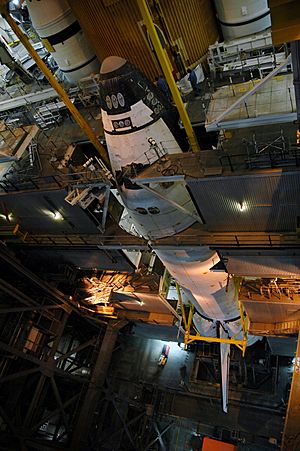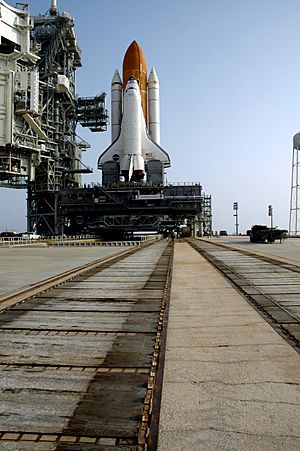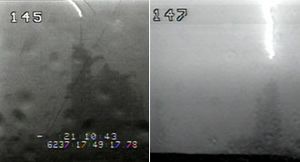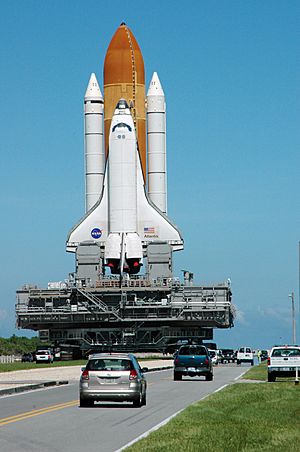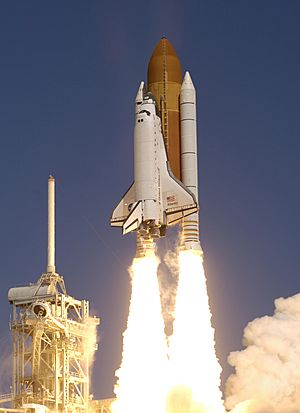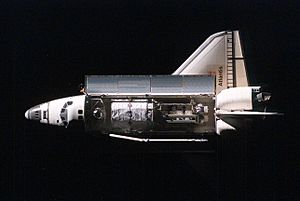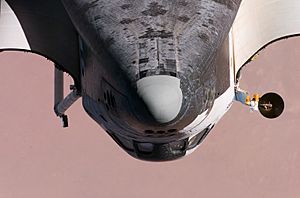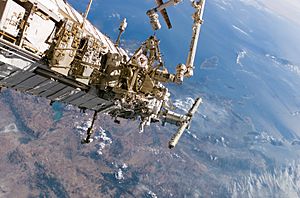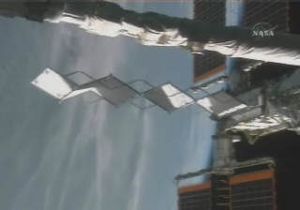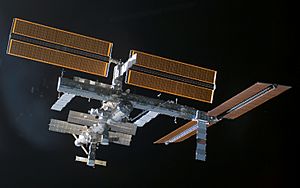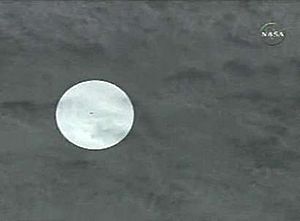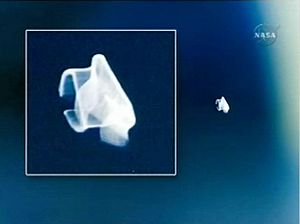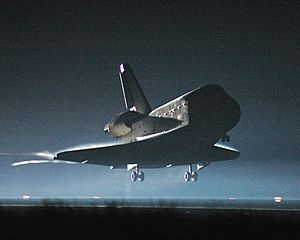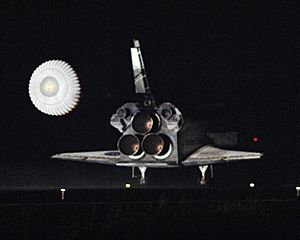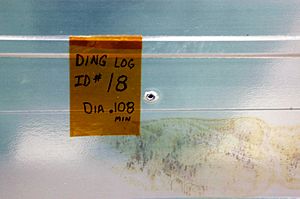STS-115 facts for kids
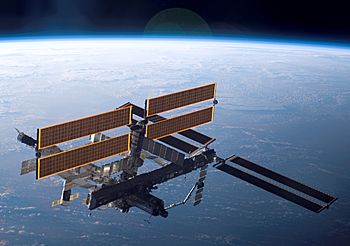
The ISS above Earth, following the installation of a new truss segment and solar arrays during STS-115
|
|
| Mission type | ISS assembly |
|---|---|
| Operator | NASA |
| Mission duration | 11 days, 19 hours, 6 minutes, 35 seconds |
| Distance travelled | 7,840,000 kilometres (4,870,000 mi) |
| Orbits completed | 188 |
| Spacecraft properties | |
| Spacecraft | Space Shuttle Atlantis |
| Launch mass | 2,000 tonnes (4,400,000 lb) |
| Crew | |
| Crew size | 6 |
| Members |
|
| Start of mission | |
| Launch date | 9 September 2006, 15:14:55 UTC |
| Launch site | Kennedy LC-39B |
| End of mission | |
| Landing date | 21 September 2006, 10:21:30 UTC |
| Landing site | Kennedy SLF Runway 33 |
| Orbital parameters | |
| Reference system | Geocentric |
| Regime | Low Earth |
| Perigee | 157.4 kilometres (97.8 mi) |
| Apogee | 226.6 kilometres (140.8 mi) |
| Inclination | 51.6 degrees |
| Period | 91.6 minutes |
| Docking with ISS | |
| Docking port | PMA-2 (Destiny forward) |
| Docking date | 11 September 2006, 10:46 UTC |
| Undocking date | 17 September 2006, 12:50 UTC |
| Time docked | 6 days, 2 hours, 4 minutes |
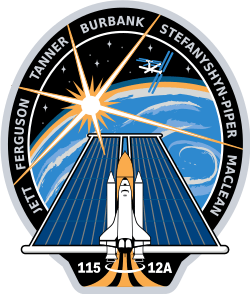 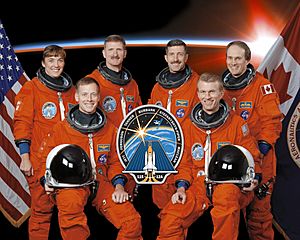 (L-R) Heidemarie M. Stefanyshyn-Piper, Christopher J. Ferguson, Joseph R. Tanner, Daniel C. Burbank, Brent W. Jett Jr., Steven MacLean |
|
STS-115 was a Space Shuttle mission to the International Space Station (ISS). It was flown by the Space Shuttle Atlantis. This mission was very important because it was the first time a new part was added to the ISS after the Columbia disaster. Two earlier missions, STS-114 and STS-121, had successfully returned to space safely.
STS-115 launched from Kennedy Space Center on September 9, 2006. The mission's main goal was to deliver and install a large part of the ISS called the P3/P4 truss segment. This truss included new solar arrays and batteries. The astronauts also performed three spacewalks to connect these new parts and prepare them for use.
The mission was first planned for April 2003. However, the Columbia accident in February 2003 caused many delays. The launch date was moved several times, even because of a tropical storm and a strong lightning strike at the launchpad.
Contents
- Meet the Astronauts: STS-115 Crew
- Mission Goals and Equipment
- Mission Facts and History
- STS-115 Mission Journey
- Getting Ready for Launch
- September 8: First Launch Attempt
- September 9: Launch Day! (Flight Day 1)
- September 10: Checking the Shuttle (Flight Day 2)
- September 11: Docking with the ISS (Flight Day 3)
- September 12: Installing the Truss (Flight Day 4)
- September 13: Activating the Solar Array Joint (Flight Day 5)
- September 14: Unfolding the Solar Arrays (Flight Day 6)
- September 15: Final Spacewalk (Flight Day 7)
- September 16: Preparing to Undock (Flight Day 8)
- September 17: Leaving the ISS (Flight Day 9)
- September 18: Checking the Heat Shield (Flight Day 10)
- September 19: Mysterious Object and Delays (Flight Day 11)
- September 20: Cleared for Landing (Flight Day 12)
- September 21: Landing Day! (Flight Day 13)
- After the Flight: What Happened Next?
- Wake-Up Music: Songs from Space
- Rescue Mission Plans: STS-300
- Images for kids
- See also
Meet the Astronauts: STS-115 Crew
| Position | Astronaut | |
|---|---|---|
| Commander | Fourth and last spaceflight |
|
| Pilot | First spaceflight |
|
| Mission Specialist 1 | Second and last spaceflight |
|
| Mission Specialist 2 | Second spaceflight |
|
| Mission Specialist 3 | Fourth and last spaceflight |
|
| Mission Specialist 4 | First spaceflight |
|
The P3/P4 Truss segment and its batteries were very heavy. They weighed more than 16,000 kilograms (about 35,000 pounds)! Because of this heavy load, the crew size was reduced from seven astronauts to six.
Mission Goals and Equipment
The main cargo for STS-115 was a large section of the ISS truss called P3/P4. This section also carried new solar panels and their batteries.
What Were the Main Goals?
- Deliver and install two large truss segments (P3 and P4) to the ISS.
- Unfold and set up two new solar arrays (4A and 2A) to generate power.
- Perform three spacewalks to connect the new parts and get the station ready for future missions.
Mission Facts and History
NASA managers decided to launch STS-115 on August 27 to get better photos of the shuttle's external fuel tank during launch. This mission was also planned to fit around the launch of a Russian Soyuz spacecraft in mid-September. The Soyuz would bring new crew and supplies to the ISS. Shuttles and Soyuz spacecraft usually do not dock at the station at the same time.
This mission was special for several reasons:
- It was the 147th time NASA sent a crew into space.
- It was the 116th flight of a Space Shuttle since the very first one, STS-1.
- It was the 27th flight for the Space Shuttle Atlantis.
- It was the 91st mission after the Challenger accident.
- It was the 3rd mission after the Columbia accident.
- It was the first mission of Atlantis after the Columbia accident.
STS-115 Mission Journey
Getting Ready for Launch
The Space Shuttle Atlantis was moved from its special processing building to the Vehicle Assembly Building (VAB) on July 24, 2006. In the VAB, it was attached to its large fuel tank and booster rockets. Then, on August 2, it was rolled out to Launch Pad 39B. This move was delayed by two days because of a storm. NASA worried that lightning could damage the shuttle.
On August 5-6, engineers checked the shuttle's main engines and confirmed they were ready. The crew arrived on August 7 for four days of practice, including a full countdown rehearsal.
NASA leaders held a meeting on August 15-16 to decide the final launch date. A big concern was foam falling off the external tank during launch. This foam caused the Columbia disaster. They also discussed issues with bolts on the shuttle's Ku-band antenna. Even with these concerns, NASA decided to launch on August 27. However, the antenna bolts were replaced while Atlantis was still on the launch pad.
On August 25, a very powerful lightning strike hit the launch pad. This was the strongest lightning strike ever recorded at Kennedy Space Center. Because of this, the launch was delayed by at least 24 hours to check for damage. The launch was delayed again due to the possible threat from Tropical Storm Ernesto.
On August 28, NASA decided to move Atlantis back into the VAB because Hurricane Ernesto was expected to be stronger. But then, forecasters changed their minds, saying the storm wouldn't be as bad. So, Atlantis was moved back to the launch pad on August 29. This was a very unusual move!
By August 31, the storm had passed. Only minor damage was found. A new launch date was set for September 6. The official countdown began on September 3. However, a problem with one of the shuttle's fuel cells caused another delay. NASA then aimed for a launch on September 8.
September 8: First Launch Attempt
On the morning of September 8, one of the engine cut-off (ECO) sensors in the external tank failed. These sensors tell the shuttle when the fuel tank is empty. NASA decided to delay the launch for another 24 hours to check the problem. Even though one sensor was faulty, the other three worked correctly. NASA could launch with three working sensors if needed.
| Attempt | Planned | Result | Turnaround | Reason | Decision point | Weather go (%) | Notes |
|---|---|---|---|---|---|---|---|
| 1 | 8 Sep 2006, 11:40:37 am | scrubbed | — | technical | 8 Sep 2006, 4:00 am (T– 9:00 hold) | 70% | engine cut-off (ECO) sensor failure, |
| 2 | 9 Sep 2006, 3:14:55 pm | success | 1 day, 3 hours, 34 minutes |
September 9: Launch Day! (Flight Day 1)
On September 9, 2006, all engine cut-off sensors worked perfectly. After a smooth countdown, Atlantis lifted off at 11:15 AM EDT (3:15 PM UTC). At the moment of launch, the International Space Station was about 350 kilometers (220 miles) above the northern Atlantic Ocean.
During the climb to orbit, mission control asked the crew to adjust a cooling system that seemed to have ice. The adjustment fixed the problem, and the system worked normally. This kind of temporary ice is not uncommon.
After the main engines shut down, astronauts Joe Tanner and Steve MacLean took videos and photos of the external tank as it separated from the shuttle. These images were sent to Earth for review.
September 10: Checking the Shuttle (Flight Day 2)
On their first full day in space, the crew carefully checked Atlantis using the Orbiter Boom Sensor System. This is a 15-meter (50-foot) extension for the shuttle's robotic arm. Pilot Chris Ferguson and mission specialists Dan Burbank and Steve MacLean slowly inspected the heat shield panels on the wings and nose of Atlantis.
The crew also prepared for docking with the ISS and for the three planned spacewalks. Mission specialists Joe Tanner and Heide Stefanyshyn-Piper checked the spacesuits and tools they would use.
On the space station, astronaut Jeffrey Williams prepared the ISS for Atlantis' arrival. He got digital cameras ready to take high-resolution photos of the shuttle's heat shield. He also prepared the docking port where Atlantis would connect.
September 11: Docking with the ISS (Flight Day 3)
Before docking, Commander Jett flew Atlantis in a special backflip maneuver about 180 meters (600 feet) below the ISS. This allowed the ISS crew to take many detailed photos of the shuttle's heat shield.
At about 10:46 AM UTC, Atlantis docked with the International Space Station. Almost two hours later, the hatch between the shuttle and the station was opened. The crew of Atlantis was welcomed aboard the ISS at 12:35 PM UTC.
After docking, astronauts Ferguson and Burbank used the shuttle's robotic arm to grab the 17.5-ton P3/P4 truss. They lifted it from the shuttle's cargo bay and handed it over to the station's Canadarm2. Steve MacLean, a Canadian astronaut, was the first Canadian to operate the Canadarm2 in space during this task.
Joe Tanner and Heide Stefanyshyn-Piper began preparing for their spacewalk on Day 4. This involved a "camping out" procedure in the Quest Airlock. They wore oxygen masks and slept in the airlock with lower air pressure. This helps their bodies get used to the low pressure inside their spacesuits and prevents decompression sickness, also known as "the bends."
September 12: Installing the Truss (Flight Day 4)
After the Canadarm2 installed the P3/P4 Truss onto the ISS, Joe Tanner and Heide Stefanyshyn-Piper began their spacewalk at 9:17 AM UTC. During their spacewalk, they connected power and data cables between the old and new truss parts. They also released clamps that held the P3/P4 truss in place during launch. The spacewalk was so successful that they completed extra tasks planned for later spacewalks. The spacewalk ended at 3:43 PM UTC. A small bolt, spring, and washer were lost during these extra activities and floated away into space.
After the spacewalk, astronauts Dan Burbank and Steve MacLean began their "camp out" preparations in the Quest Airlock at 6:40 PM UTC, getting ready for their spacewalk on Day 5.
September 13: Activating the Solar Array Joint (Flight Day 5)
On Day 5, the second spacewalk of the mission took place. This time, it was performed by Dan Burbank and Steve MacLean, who were doing their first spacewalks. They worked on activating the Solar Alpha Rotary Joint (SARJ). This joint is as big as a car and allows the station's solar panels to turn and follow the sun. Burbank and MacLean released locks that held the joint secure during launch. They faced a few small problems, like a broken tool and a stubborn bolt, but they managed to fix them.
Burbank and MacLean spent 7 hours and 11 minutes outside the station. They started their spacewalk at 9:05 AM UTC and finished at 4:16 PM UTC. They also completed some "get-ahead" tasks, which were jobs planned for later missions.
Engineers found a small issue during the activation of the SARJ. This temporarily delayed the unfolding of the new solar arrays. However, they had enough time to work on the problem and still deploy the arrays as planned.
September 14: Unfolding the Solar Arrays (Flight Day 6)
Day 6 focused on unfolding the solar panels. The unfolding started a little late because of the SARJ problem from Day 5. Engineers found that the problem was in the software and developed a solution. The panels were unfolded slowly, in stages, to prevent them from sticking together, which had happened on an earlier mission (STS-97). The crew noticed some panels were still sticking, but it didn't cause any major issues. These new solar arrays would not provide power to the station until the next shuttle mission, STS-116, which would rewire the station's electrical system.
Other activities on Day 6 included moving the station's Canadarm2 and preparing for the third spacewalk. Commander Jett and Steve MacLean also had interviews with Canadian Prime Minister Stephen Harper and students.
September 15: Final Spacewalk (Flight Day 7)
Flight Day 7 featured the third and final spacewalk of the STS-115 mission. The spacewalk was delayed because a power switch tripped, causing the airlock's pump to lose power. After checking that there was no short circuit, the switch was reset. Joe Tanner and Heide Stefanyshyn-Piper began their spacewalk at 10:00 AM UTC, 45 minutes late.
During their 6-hour and 42-minute spacewalk, the astronauts performed many maintenance and repair tasks. They removed hardware that secured the P3/P4 radiator during launch. After this, ground controllers unfolded the radiator, which helps the station release heat into space. They also retrieved a materials experiment from outside the ISS, performed maintenance on another truss, installed a wireless TV antenna, and replaced a different antenna.
The astronauts also completed several "get-ahead" tasks, which were jobs originally planned for future missions. Near the end of the spacewalk, they tested using an infrared camera to check Atlantis' wing for any damage from space debris.
After the spacewalk, the station's mobile transporter was moved to the P3 truss to inspect parts of it.
September 16: Preparing to Undock (Flight Day 8)
Day 8 was the last full day that Space Shuttle Atlantis was docked to the ISS. The crew spent the morning resting after their successful mission. Then, they began preparing for undocking by moving ISS equipment and science experiments onto Atlantis for the trip back to Earth.
The crews of Expedition 13 and STS-115 also held a joint news conference. Mission Commander Brent Jett spoke about the success of the mission and how it helped prepare for future construction missions. He said, "All of the rest of the assembly missions are going to be challenging. We are off to a good start on assembly. I think we can pass along a lot of the lessons to the future crews."
September 17: Leaving the ISS (Flight Day 9)
Flight Day 9 marked the end of STS-115's work at the ISS. Atlantis undocked from the International Space Station at 12:50 PM UTC.
After saying goodbye, the hatch between Atlantis and the ISS was closed and locked at 10:27 AM UTC. After checking for any leaks, Atlantis slowly moved away. It then performed a full 360-degree fly-around of the expanded ISS. This allowed the crew to take pictures of the station's new shape.
September 18: Checking the Heat Shield (Flight Day 10)
On Flight Day 10, the STS-115 crew spent the morning doing final checks of Atlantis' heat shield. This was to make sure it was ready for re-entry on Flight Day 12.
Orbiting about 80 kilometers (50 miles) behind the ISS, the crew used the shuttle's robotic arm and boom sensor system. They checked the nose and wing edges of Atlantis for any damage from tiny space debris. The rest of the day was spent putting away equipment to get ready for landing.
September 19: Mysterious Object and Delays (Flight Day 11)
On the morning of Day 11, astronauts Jett and Ferguson tested Atlantis' thrusters and practiced for landing using the shuttle's computers. The thrusters are important for guiding the shuttle during re-entry.
The crew also gave interviews. Ferguson said everyone was looking forward to landing and felt good about their work. Later that day, the crew saw an object moving alongside Atlantis. They used an on-board TV camera, but the images were not clear enough to identify it.
The images were sent to Mission Control for analysis. Controllers were worried the object might have come off Atlantis. The most likely explanation was that it was something harmless, like ice or a piece of material that had come loose. However, there was a chance it could be something important, like a heat shield tile. Mission Control asked the crew to get the robotic arm ready to inspect the shuttle again. They also made plans for more tests on Flight Day 12. Because of this extra inspection and bad weather forecasts for the landing site, the landing was delayed by a day.
September 20: Cleared for Landing (Flight Day 12)
After finding the mysterious object, flight controllers spent the early morning using the robotic arm to inspect the top surface of Atlantis. The astronauts then scanned the underside of the shuttle for any concerns. After reviewing these scans, Mission Control in Houston confirmed that Atlantis was safe for re-entry. This good news, along with a better weather forecast, meant Atlantis was cleared to land the next day.
The crew spent the rest of the day preparing for landing, packing up gear, and stowing the Ku-band antenna used for TV broadcasts. During the inspection, the crew learned that the Soyuz TMA-9 spacecraft had docked with the ISS, carrying the first part of the Expedition 14 crew.
September 21: Landing Day! (Flight Day 13)
Flight Day 13 was the last day of the mission, with the re-entry and landing taking place in the morning. The landing process began hours before Atlantis touched down at Kennedy Space Center. The crew received the final "Go" for landing at 4:52 AM EDT. They then turned the shuttle so its engines faced its direction of travel. Firing the engines would slow Atlantis down and begin its journey out of orbit.
The de-orbit burn started at 5:15 AM EDT and lasted 2 minutes and 40 seconds. The astronauts were told their burn was perfect as Atlantis began its descent over the Indian Ocean.
After the de-orbit burn, the crew dumped extra fuel. At 5:51 AM EDT, Atlantis began to feel the effects of Earth's atmosphere at about 130 kilometers (80 miles) high. It then performed a special "roll reversal banking" maneuver to slow down from 27,000 km/h (17,000 mph) to less than 760 km/h (470 mph) for landing. The ISS was positioned to allow its astronauts to watch Atlantis' re-entry from above.
At 6:08 AM EDT, the shuttle's signal was picked up by a tracking station in Florida. Ten minutes later, two loud sonic booms were heard at Kennedy Space Center as Atlantis broke the sound barrier. Commander Jett took control of Atlantis and guided it towards Runway 33.
Atlantis' main landing gear touched down at 6:21:30 AM EDT on Runway 33 at the Space Shuttle Landing Facility. The nose gear followed 6 seconds later. After traveling 8 million kilometers (5 million miles), the shuttle came to a complete stop at 6:22:16 AM EDT, ending mission STS-115.
This landing was considered a night landing because it happened about 48 minutes before sunrise. It was the 21st night landing for the Space Shuttle Program, the 63rd landing at Kennedy Space Center, and the 27th mission for Atlantis.
After the Flight: What Happened Next?
While working on the Atlantis shuttle after its return, NASA technicians found a small hole in one of its radiator panels. This hole, about 2.7 millimeters (0.108 inches) wide, was caused by a tiny piece of space rock, called a micrometeorite.
Wake-Up Music: Songs from Space
Since the early days of spaceflight, NASA missions have a tradition of playing a special song to wake up the crew each day in space. These songs are often chosen by the astronauts' families and usually have a special meaning to one of the crew members or relate to their daily tasks.
| Flight Day | Song | Artist | Played for | Links |
|---|---|---|---|---|
| Day 2 |
"Moon River" | Audrey Hepburn | Brent Jett | wav mp3 Transcript |
| Day 3 |
"cello & double bass" | Daniel Burbank's children | Daniel Burbank | wav mp3 Transcript |
| Day 4 |
"My Friendly Epistle" | Taras Shevchenko | Heidemarie Stefanyshyn-Piper | wav mp3 Transcript |
| Day 5 |
"Takin' Care of Business" | Bachman–Turner Overdrive | Steve MacLean | wav mp3 Transcript |
| Day 6 |
"Wipe Out" | The Surfaris | Chris Ferguson | wav mp3 Transcript |
| Day 7 |
"Hotel California" | The Eagles | Joseph Tanner | wav mp3 Transcript |
| Day 8 |
"Twelve Volt Man" | Jimmy Buffett | Daniel Burbank | wav mp3 Transcript |
| Day 9 |
"Danger Zone" | Kenny Loggins | Chris Ferguson | wav mp3 Transcript |
| Day 10 |
"Rocky Mountain High" | John Denver | Joseph Tanner | wav mp3 Transcript |
| Day 11 |
"Ne Partez Pas Sans Moi" | Celine Dion | Steve MacLean | wav mp3 Transcript |
| Day 12 |
"Beautiful Day" | U2 | Heidemarie Stefanyshyn-Piper | wav mp3 Transcript |
| Day 13 |
"WWOZ" | Better Than Ezra | Brent Jett | wav mp3 Transcript |
Rescue Mission Plans: STS-300
STS-300 was the name given to a special rescue mission. This mission would have launched if Space Shuttle Discovery had become stuck in space during its earlier missions, STS-114 or STS-121. This rescue mission would have been a changed version of the STS-115 mission, launching earlier and with a smaller crew.
STS-300 would have launched no earlier than August 17, 2006. The crew for STS-300 would have been four astronauts from the STS-115 crew:
- Brent Jett, commander
- Christopher Ferguson, pilot
- Joseph Tanner, mission specialist and main robotic arm operator
- Daniel Burbank, mission specialist
Images for kids
See also
 In Spanish: STS-115 para niños
In Spanish: STS-115 para niños



